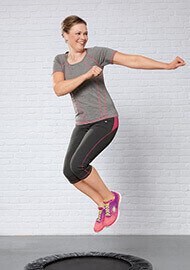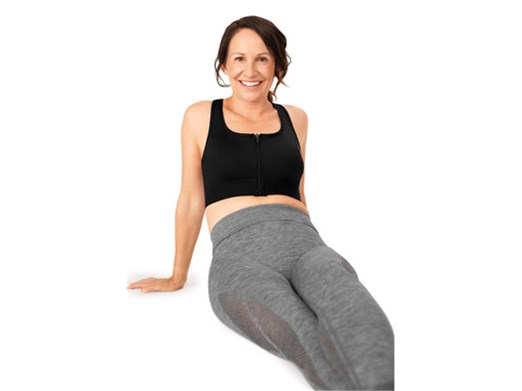Ready to Bounce to Better Health?
Rebounding is both low-impact cardio and lymph circulation therapy
 With more and more women living longer after breast cancer, research focus often turns to living with the effects of the disease and its treatments — and one of the most significant is the lingering risk of lymphedema.
With more and more women living longer after breast cancer, research focus often turns to living with the effects of the disease and its treatments — and one of the most significant is the lingering risk of lymphedema.
Exercise can help prevent and manage lymphedema, and recently rebounding —a workout that uses the mini-trampoline — is getting a second look. You remember the mini-tramp, of course: that classic weight-loss tool of the 1980s (along with leg warmers and headbands). It has enjoyed a resurgence in recent years, bolstered in part by doctors’ increased understanding of the lymphatic system. Some experts say rebounding is the only exercise that can move lymph fluid vertically, with its gravitational force and rhythmic motion.
Jump to it: Exercise is IN again!
Fitness centers and athletic clubs worldwide have added rebounding classes to their calendars, and with higher-quality home trampolines available, consumers are buying their own rebounders as well.
 “I think [rebounding is] coming back because it addresses so many fitness and health issues in a single, enjoyable, and convenient workout, which are things people are really starting to appreciate,” explains John Hines of bellicon USA, one of the premier manufacturers of high-end rebounders. “In many ways, Americans are less healthy now than they were before the fitness boom of the ’70s and ’80s. Our lifestyle has changed a lot in 40 years. People are more inactive than they used to be, which also makes us vulnerable to a host of health problems.”
“I think [rebounding is] coming back because it addresses so many fitness and health issues in a single, enjoyable, and convenient workout, which are things people are really starting to appreciate,” explains John Hines of bellicon USA, one of the premier manufacturers of high-end rebounders. “In many ways, Americans are less healthy now than they were before the fitness boom of the ’70s and ’80s. Our lifestyle has changed a lot in 40 years. People are more inactive than they used to be, which also makes us vulnerable to a host of health problems.”
Most consumers realize they need to find exercise that is enjoyable, in order to make it a habit. This varies for everyone, but rebounding classes are filling up for a reason – many folks agree that bouncing on a trampoline is fun!
Lymphatic system: Understand the flow
Your lymphatic system is a part of your circulatory system, carrying fluid from tissues to lymph nodes via a network of its own vessels. Lymph fluid is very similar to blood plasma but contains disease-fighting white blood cells (lymphocytes), waste products and cellular debris, along with protein and bacteria.
The major difference between the cardiovascular system and the lymph system is that the lymph system doesn’t use the heart to pump its fluid. Motion is typically slow and lacks pressure. Lymphatic circulation can be stimulated by manual drainage (massage), muscle contraction and aerobic exercise. Walking, dancing, swimming, hiking and Pilates are all healthy options, but according to popular wellness literature (note that there haven’t been any definitive scientific studies to date), the rhythmic bounce of rebounding allows lymph valves to open and close simultaneously, and this can increase lymph flow significantly.
“People with any existing health issues need to talk to their doctor first before beginning any new type of workout,” advises Hines. It’s also recommended that people with lymphedema wear compression garments when exercising. But proponents of rebounding and its resultant lymph-moving say the benefits are numerous:
- Cleans out toxins such as dead and cancerous cells, other wastes, infectious viruses and metals
- Strengthens the immune system by removing antigens
- Protects the joints from hard landings and fatigue (it’s been called the second-best low-impact exercise, after swimming)
- Improves balance and coordination
- Works the heart more efficiently; 20 minutes on a rebounder is said to compare to 1 hour of running
- Brings out your inner child – jumping is a fun workout!
Working up a sweat without wearing down your joints — and feeling like a kid again? Sounds like something we should all try!
Speaking of Sweating…
If you want to avoid the discomfort of sweating behind your breast form, we have a better option: Amoena Energy, pair this with pocketed activewear and you will be at your most comfortable to perform your best.







